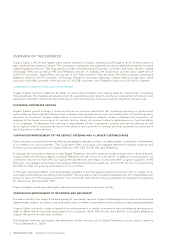Cogeco 2006 Annual Report Download - page 18
Download and view the complete annual report
Please find page 18 of the 2006 Cogeco annual report below. You can navigate through the pages in the report by either clicking on the pages listed below, or by using the keyword search tool below to find specific information within the annual report.16 COGECO CABLE INC. 2006 Management’s Discussion and Analysis
RISKS PERTAINING TO MARKETS AND COMPETITION
Broadband telecommunications markets in Canada and Portugal are very dynamic and highly competitive. They involve
intense rivalry between a variety of terrestrial wireline and wireless, as well as satellite, service providers over a widening
suite of broadband services that include fi xed and mobile voice communications, Internet access, data communications,
audio and video content delivery, electronic programming guides and navigation, security and other related or incidental
services. While cable broadband telecommunications providers have entered into the voice and data communications
markets traditionally dominated by incumbent telephone companies, the telephone companies are increasingly involved
in audio and video content delivery, as part of a global phenomenon known as convergence. A number of new competitors
have also entered various telecommunications markets through the use of the Internet and access to the facilities of
telephone and cable telecommunications companies.
In this converged environment, competition increasingly unfolds over bundles of services offered at attractive package
rates, as competitors strive to meet all the communications needs of residential and business customers and thus obtain
maximum share of their overall communications budget. Rivalry extends over the composition of service bundles, bundle
prices and perceived value, promotional or introductory offers, term of commitment by the customer, terminal devices and
customer service. The substantial cost of broadband facilities and broadband customer acquisition, combined with the
signifi cant annual growth rates of revenue generating units achieved by competitors generally tend to make outright price
wars on individual services and service bundles less appealing as a competitive strategy. As markets mature and penetration
gains for high speed Internet access, digital video and digital telephony services abate, retail pricing strategies may become
more aggressive, with resulting downward pressure on operating margins of both individual services and service bundles.
Cogeco Cable provides “double-play” and “triple-play” service bundles in its various geographic markets, with various
combinations of voice, Internet and video distribution services being offered at attractive bundle prices. “Quadruple-play”
service bundles that include mobile communications have appeared in these markets, but so far they have had limited
effect in the marketplace. Cogeco Cable continues to focus at this time on its existing lines of service with a view to
capturing the remaining growth opportunities for HSI, Digital Television and Digital Telephony services in its footprint,
making the most effi cient use of its own hybrid fi bre-coaxial (HFC) plant. Mobile telephone operators are now offering
audio and video content distribution directly to their mobile telephone customers, but this new form of content distribution
has so far had no measurable impact on the use of wireline and satellite content distribution. As markets evolve and
mobility becomes a more cost-effective substitute to wireline communications, Cogeco Cable and its subsidiaries may need
to add mobility components to its service bundles, through suitable mobile virtual network arrangements with existing
mobile operators.
In Canada, Cogeco Cable faces competition in its service areas mainly from two national direct-to-home satellite distribution
services, Star Choice and Bell ExpressVu (the latter controlled by BCE Inc., the largest and most widely integrated Canadian
telecommunications company), and from incumbent telephone companies Telus, Bell Canada (controlled by BCE Inc.) and
Bell Nordiq (also controlled by BCE Inc.). Star Choice and Bell ExpressVu both offer a wide range of competitive audio and video
services on a fully digital basis. Telus, Bell Canada and Bell Nordiq all offer a wide range of business and residential
Internet access, voice and data telecommunications services. Rogers, Telus and Bell Canada respectively operate mobile
telecommunications services in Ontario and Québec. In addition, Telus now offers audio and video distribution services in
the Lower St. Lawrence area in direct competition with Cogeco Cable. Telus and Bell Canada have recently announced that
they will become income trusts. However, Cogeco Cable and Telus cooperate in other parts of Cogeco Cable’s footprint to
offer Cogeco Cable’s Digital Telephony service. Bell Canada offers a new digital telephone service in Ontario and
Québec and is expected to launch some time in 2007 a new digital video distribution service over its wireline network,
starting with larger urban centres in Ontario and Québec, some of which are included in Cogeco Cable’s cable network
footprint. Cogeco Cable also competes with other telecommunications service providers, including Vonage, Primus and
Rogers Home Phone (formerly known as Sprint), and with alternative service providers who use resale or third-party access
arrangements in effect. Although spectrum has been allocated for broadband wireless distribution alternatives for quite
some time, this form of wireless competition has been slow to develop in Cogeco Cable’s footprint. It may however become
a more signifi cant competitive factor in coming years.
























